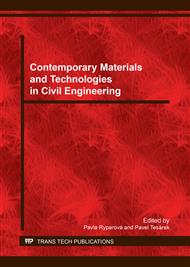p.10
p.15
p.23
p.29
p.37
p.43
p.49
p.55
p.60
Hydration Heat Evolution of the Cement Paste with Recycled Concrete: Influence of Grain Size Distribution of Recycled Concrete Powder
Abstract:
The paper deals with the influence of level of grinding of the recycled concrete. Level of grinding mostly influence the hydration heat evolution of cement paste. Measurement of hydration heat evolution is one of the ways to detect reactive properties of recycled concrete powder modified by high speed mill device. Basic characteristics that most influence the hydraulic properties of recycled concrete powder are grin size diagram and chemical composition of the original concrete. Non-hydrated inner part of cement grains could further react if it is exposed to water. In this experiment the recycled concrete from recycled railroad sleepers and structural layers of the D2 highway was used. Recycled concrete powder from highway was divided into 4 more variants which differ by grinding process during production. To detect difference in hydration process four mixtures of cement paste with different types of recycled concrete powder were made and further subjected to calorimetric measurement. The results were after compared with the hydration heat rate of reference cement paste. According to results the type of milling process had minor influence on hydraulic properties of recycled concrete powder compared with influence of origin of recycled concrete.
Info:
Periodical:
Pages:
37-42
Citation:
Online since:
March 2017
Authors:
Price:
Сopyright:
© 2017 Trans Tech Publications Ltd. All Rights Reserved
Share:
Citation:


